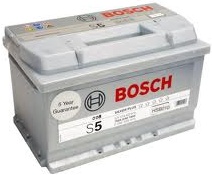 |
 |
 |
 |
How to Find the Best Car Battery
Before you buy a new car battery, make sure your old battery is really malfunctioning and not just discharged. Fully charge and test your current battery. Only when it no longer passes the tests, it is time to buy a new car battery. If you are satisfied with the old battery performance, you can buy the same model once again. Otherwise read on what qualities the best car battery possesses and how to find a model compatible with your car.
In general, the best car battery is the heaviest, freshest, with largest reserve capacity (RC) and largest cold cranking amp performance (CCA). In cold climates, higher CCA performance is more important than RC. In a hot climate, higher RC is more important than CCA. Some auto battery manufacturers build specific "North" and "South" car battery versions for cold and hot climates to better accommodate these requirements.
Car battery sizes
In North America, manufacturers use Battery Council International (BCI) Group Size Number standard to specify car batteries. It includes the physical case size, terminal placement, type and polarity. In Europe, European Type Numbering (ETN) standard is used. An ETN number includes the voltage, amp hour capacity, physical case size, case base hold down, type and layout of terminals (poles), polarity and cold cranking current.
The number on the battery originally installed by the vehicle's manufacturer is a good starting place to determine the replacement car battery size. Within a size, the CCA and RC ratings, warranty and battery type will vary within models of the same brand or from brand to brand. Potentially, a physically larger battery with more CCA or RC can be purchased than the battery being replaced. If you decide to buy a physically larger car battery, make sure that the new car battery will fit, the cables will connect to the correct terminals, and that the terminals will not touch metal surfaces such as the hood when it is closed.
Car battery types
Between standard (Sb/Sb), low maintenance (Sb/Ca) and maintenance free (Ca/Ca) car batteries, the maintenance free is the best car battery due to less water loss, smaller self-discharge rate and less need for maintenance. AGM [Absorbed Glass Mat] (Ca/Ca) batteries are more expensive, but have longer service life (typically up to twice as long). Gel Cell (Ca/Ca) batteries are even more expensive than AGM, but provide up to 20% more life cycles. Disadvantages of Gel Cell batteries are lower capacity in cold temperatures and less Cold Cranking Amps.
When selecting a battery type, it is extremely important that you select a battery that will match the voltage outputs of your charging system and application. The easiest way to accomplish this is to replace your battery with the same or compatible type of battery that originally was installed in your vehicle or appliance. For example, an AGM (Ca/Ca) battery can normally replace a low maintenance (Sb/Ca) or maintenance free (Ca/Ca) battery, but a low maintenance (Sb/Ca) battery normally cannot replace an AGM (Ca/Ca) battery without adjusting the charging voltages.
Cold Cranking Amp (CCA) performance
The battery's CCA performance rating should be best suited for the coldest temperatures encountered in your climate. CCA of a car battery is measured at 0° F (-17.8° C). Do not confuse it with other ratings such as Cranking Amps (CA) measured at 32° F (0° C) and Hot Cranking Amps (HCA) measured at 80° F (26.7° C).
In hot climates, buying car batteries with double or triple your vehicle's cold cranking amp requirements is a waste of money because the extra amps will not be used. A starter motor will only demand what it needs to operate. However, in extremely cold climates a higher CCA rating is better, due to increased power required to crank a sluggish engine and the inefficiency of a cold car battery:
| Temperature, °F | Temperature, °C | Available power from battery | Power required to crank engine |
|---|---|---|---|
| 80 | 27 | 100% | 100% |
| 32 | 0 | 65% | 155% |
| 0 | -18 | 40% | 210% |
| -20 | -29 | 25% | 350% |
Reserve Capacity (RC) and Amp Hour (AH) capacity
For car batteries, an equally important consideration to CCA is the Reserve Capacity (RC) and Amp Hour (AH) endurance ratings. Endurance is defined by Eurobat as the actual combination of the energy content stored in a battery and the rate which the battery is discharged over the life time. RC is the number of minutes a fully charged battery at 80° F (26.7° C) can be discharged at a constant 25 amps until the voltage falls below 10.5 volts. European and Asian automotive batteries are usually rated in Amp Hours (AH). More RC (or AH) is better in every case. There is also a relationship between the weight of the battery and the amount of RC (or AH). The heavier the battery, the more lead it has and potentially a longer service life.
Freshness
Lead-acid batteries are perishable and sulfate in storage due to their natural self-discharge, especially in temperatures above 80° F (26.7° C). For a car battery, the date of formation is often stamped on the case or printed on a sticker. Unfortunately each manufacturer encodes this date in its own format. If you cannot determine the date code, ask the dealer or contact the distributor or manufacturer. Because of permanent sulfation due to self-discharge, the freshest battery is the best car battery. If at all possible, have a new car battery tested, and recharged if necessary, before the battery leaves the store. This can save a lot of time and frustration if the new car battery is sulfated or has a manufacturing defect.